
Oxon Cove Park and Oxon Cove Farm is a national historic district that includes a living farm museum operated by the National Park Service, and located at Oxon Hill, Prince George's County, Maryland. It is part of National Capital Parks-East. It was listed on the National Register of Historic Places in 2003.
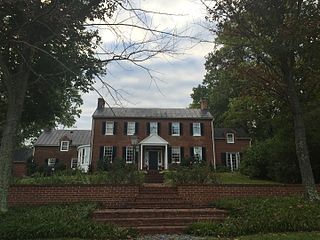
East Oaks is a historic home and farm complex and national historic district located at Poolesville, Montgomery County, Maryland. It is a 156-acre (0.63 km2) farm complex consisting of a 2+1⁄2-story, c. 1829 Federal-period brick residence situated on a knoll surrounded by agricultural buildings and dependencies whose construction dates span more than a century. The complex of domestic and agricultural outbuildings includes a brick smokehouse, sandstone slave quarter, stone bank barn, stone dairy, and log and frame tenant house which are contemporaneous with the construction of the main dwelling. Other agricultural buildings include a small frame barn and machinery shed/corn crib from the end of the 19th century, and a block dairy barn from the mid 20th century.

Cherry Grove, located on property formerly called Fredericksburg, 400 acres patented by Orlando Griffith's oldest son Henry Griffith in 1750. Cherry Grove is a historic home and former plantation located at Woodbine, Howard County, Maryland, United States. The home is considered the seat of the Warfield family of Maryland.

The Curtis—Shipley Farmstead is a historic home located at Ellicott City, Howard County, Maryland, United States. It is located on the first land grant in modern Howard County, then Anne Arundel County, to the English settler Adam Shipley in 1688 who settled properties in Maryland as early as 1675. The 500-acre estate was called "Adam the First".
James Owens Farm is a historic home and farm at Bristol, Anne Arundel County, Maryland. The home was built by successful tobacco farmer James Owens and is a large mid-19th century, two-story brick cross-gable late Greek Revival/Italianate dwelling. Outbuildings are all of frame construction and include an early 19th-century cornhouse, an early 19th-century tobacco barn, a mid-19th-century board-and-batten kitchen, carriage house, and smokehouse, and a late 19th-century chicken house.
McPherson's Purchase is a historic farm complex dating to the 19th century and located near Pomfret, Charles County, Maryland, United States.
Spye Park is a historic home located at White Plains, Charles County, Maryland, United States. It is a modestly scaled, 1+1⁄2-story, three-bay frame Colonial dwelling built about 1767. The house's present plan and appearance is the result of a series of 19th- and early-20th-century alterations to the original structure, which was a rectangular, one-room-deep building with end chimneys. Also on the property is a timber-framed tobacco barn, a former animal barn, a cornhouse, a poultry house/machine shed, and a wellhouse.
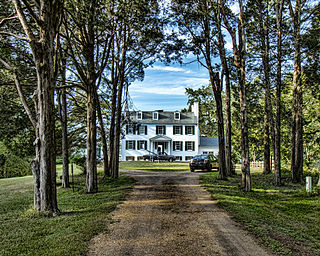
Mount Aventine is a farm complex and national historic district located along the Potomac River in Bryans Road, Charles County, Maryland. The complex includes the main house; a second-quarter 19th century Greek Revival-influenced brick house. It was enlarged about 1860 to its present five-bay, center-passage, 2+1⁄2-story appearance. Also on the property are a 19th-century frame smokehouse, the site of another 19th-century house complex, late-19th /early-20th-century agricultural outbuildings, house and dairy barn complex built about 1900, historic roadbeds, a family cemetery, and sites of a 19th-century fishery and an 18th-century house.

The Routzahn-Miller Farmstead is a historic home and farm complex located at Middletown, Frederick County, Maryland, United States. It consists of a Federal style-influenced brick house and smokehouse, both built about 1825; a later frame out-kitchen / washhouse; a standard Pennsylvania barn; a 20th-century dairy barn and milk house; and a 20th-century equipment shed. The Pennsylvania barn was probably built in the late 19th century and was recently rehabilitated for use as a preschool. The complex is located on a 16.7-acre (68,000 m2) parcel on the east flank of South Mountain. It is representative example of a type of domestic and agricultural grouping which characterized the rural mid-Maryland region from the early 19th century through World War II era.

The George Markell Farmstead, also known as Arcadian Dairy Farm and the Thomas Property, is a historic home and farm complex located at Frederick, Frederick County, Maryland, United States. It consists of brick house built about 1865, a brick smokehouse, a bake oven, two stone domestic outbuildings, an ice house, a springhouse, a frame stable, a frame chicken house, a mid-20th century guest house, and various sheds and outbuildings. Nearby is a large gambrel-roofed concrete block barn. The main house has combined Greek Revival and Italianate stylistic influences. The once large Markell dairy farm, with its lane to the Ballenger Creek ford of the Monocacy River, served as the primary approach route to the battlefield by Confederate troops during the July 9, 1864 Battle of Monocacy during the American Civil War.

Harris Farm is a historic home and farm complex located at Walkersville, Frederick County, Maryland, United States. The main house was built in 1855, and is a three-story center plan house in predominantly late Greek Revival syle, with some Italianate elements. The agricultural complex consists of a bank barn with an attached granary; a second frame barn that shares an animal yard with the bank barn; a row of frame outbuildings including a converted garage, a workshop, and a chicken house. There is also a drive-through double corn crib; and a frame pig pen from 1914. The 20th-century buildings consist of a frame poultry house, a dairy barn with milk house and two silos, and an octagonal chicken coop. A lime kiln is located on the edge of the property. The property is preserved as part of the Walkersville Heritage Farm Park.
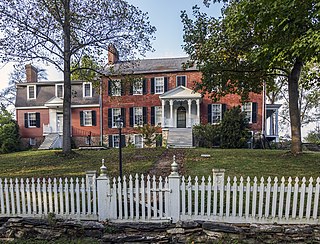
Hopewell is a set of historic homes and farm complexes located at Union Bridge, Carroll County, Maryland, United States. It consists of four related groupings of 19th century farm buildings. The Hopewell complex consists of two historic farms: Hopewell and the smaller F.R. Shriner Farm.

Mount Airy, also known as Grove Farm, is a historic home located at Sharpsburg, Washington County, Maryland, United States. It is a 2+1⁄2-story Flemish bond brick house, built about 1821 with elements of the Federal and Greek Revival styles. Also on the property are a probable 1820s one-story gable-roofed brick structure that has been extensively altered over time, a late-19th-century frame barn with metal roof ventilators, a 2-story frame tenant house built about 1900, and a mid-20th-century cinder block animal shed. It was used as a hospital for Confederate and Union soldiers following the Battle of Antietam. On October 3, 1862, President Abraham Lincoln and General George McClellan visited Mount Airy, an event recorded photographically by Alexander Gardner.
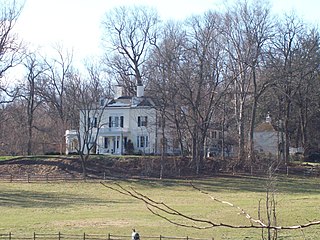
Rockland is a historic home located on Falls Road in Brooklandville, Baltimore County, Maryland. It is a 2+1⁄2-story Greek Revival-influenced house consisting of a three-bay-wide main block, constructed in 1837, with two telescoping additions, a two-bay-wide stage completed in 1852, and a three-bay-wide section built after 1890. The brick structure has been stuccoed and scored to resemble ashlar masonry. Also on the property are a smokehouse, bake oven, a large bank barn, and a late-19th-century frame shed.

Olney, originally patented as Prospect, is a historic home and farm complex located at Joppa, Harford County, Maryland. It is a 264-acre (1.07 km2) working pony farm with a collection of 15 structures ranging in style, use, and elegance. The main building on the property is a 2+1⁄2-story brick house dating to 1810, generally called "the mansion." The house was evolved into a museum of Maryland architecture, with salvaged features from demolished buildings in Baltimore and Philadelphia. These include paneling from the Isaac Van Bibber house in Fells Point, Baltimore dating to 1815; the marble Ionic portico from William Small's Baltimore Athenaeum from 1830; and a marble bas-relief plaque designed by Pierre L'Enfant for Robert Morris's great 1795 house in Philadelphia. Also on the property is an early-18th-century, 2+1⁄2-story stone dwelling and a variety of still-functioning farm structures that in themselves range in style from simple stone stables and frame hay barns to an unusual two-story brick blacksmith's shop. In addition, the 1914 Union Chapel School, was moved onto the property in 1980 and re-outfitted as St. Alban's Anglican Church. The property was developed by J. Alexis Shriver (1872–1951), a man prominent in local and state historical and agricultural matters who lived at Olney from 1890 until his death.

The Bennett-Kelly Farm is an historic home and farm complex located at Sykesville, Carroll County, Maryland, United States. The complex consists of a stone and frame house, a stone mounting block, a stone smokehouse, a frame bank barn, a frame wagon shed, a frame chicken house, a concrete block dairy or tool shed, and a stone spring house. The original mid-19th century stone section of the house is three bays wide and two stories high. The house features a one-bay Greek Revival pedimented portico with Doric columns. It is an example of a type of family farmstead that characterized rural agricultural Carroll County from the mid 19th century through the early 20th century.

The Stoner–Saum Farm is a historic home and farm complex located at Union Bridge, Carroll County, Maryland, United States. The complex consists of a brick house, a frame bank barn, a brick smokehouse, a stone ice house and summer kitchen, a stone wagon shed, and several other frame farm outbuildings. The house is a two-story, five-bay by two-bay structure with a rubble stone foundation.
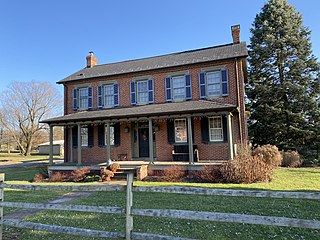
The Winemiller Family Farm is a historic home and farm complex located at Taneytown, Carroll County, Maryland, United States. The complex consists of a large two-story brick house built about 1865, a frame bank barn, and several outbuildings. It is a representative example of a type of family farm complex that characterized rural agricultural Carroll County from about 1850 through the early 20th century.
Keefer–Brubaker Farm, also known as the Oscar Fogle Farm, is a historic home and farm complex located at Taneytown, Carroll County, Maryland. It consists of a two-story six-by-two-bay log-and-frame house which is partially encased in brick and rests on a rubble stone foundation Also on the property is a frame summer kitchen, a combination smokehouse/dry house, a frame springhouse, a shop building, a bank barn, a dairy, a hog pen, a tool shed, poultry house, and several more recent buildings. It is a representative example of a family farm complex which spans the period from the late 18th century to the mid 20th century.

Carroll County Almshouse and Farm, also known as the Carroll County Farm Museum, is a historic farm complex located at Westminster, Carroll County, Maryland. It consists of a complex of 15 buildings including the main house and dependencies. The 30-room brick main house was originally designed and constructed for use as the county almshouse. It is a long, three-story, rectangular structure, nine bays wide at the first- and second-floor levels of both front and rear façades. It features a simple frame cupola sheltering a farm bell. A separate two-story brick building with 14 rooms houses the original summer kitchen, wash room, and baking room, and may have once housed farm and domestic help. Also on the property is a brick, one-story dairy with a pyramidal roof dominated by a pointed finial of exaggerated height with Victorian Gothic "icing" decorating the eaves; a large frame and dressed stone bank barn; and a blacksmith's shop, spring house, smokehouse, ice house, and numerous other sheds and dependencies all used as a part of the working farm museum activities. The original Carroll County Almshouse was founded in 1852 and the Farm Museum was established in 1965.




















